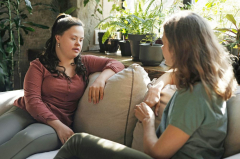Despite digital connection, many feel alone. Co-regulation may be the remedy — calming, connecting, and healing together.
We live in an increasingly hyper-individual society. Despite access to more tools of connection than ever before, it often feels like we’ve never been more anxious, alone and disconnected from our friends, families and communities. The World Health Organisation recently classified the loneliness epidemic as a global health threat, the equivalent to smoking 15 cigarettes a day.
In these uncertain and unsettling times, investing time and energy in the support networks that comfort you and help you make sense of the world has never been more important. This process is more than simply venting or blowing off steam. It’s called co-regulation and it’s a key component to maintaining your emotional and physical wellbeing.
What is co-regulation?
Co-regulation refers to the way your nervous system adapts in response to the people around you. By attuning to others’ emotional states, you’re able to bring yourself into a state of nervous-system regulation (or dysregulation) through your connection with them.
You learn how to co-regulate from the moment you’re born. As an infant, you rely entirely on your caregivers for co-regulation, learning how to calm yourself by experiencing their calming presence. Over time, you internalise these experiences, eventually becoming able to self-regulate. Co-regulation is the foundation of self-regulation, affecting how well you can independently manage your own emotional responses.
You remain wired for connection, and co-regulation, throughout your entire life. When you engage with someone in a calm and regulated state, their nervous system sends cues that help you regulate your own. These cues might include the tone of their voice, facial expressions and posture.
The interactions between your respective nervous systems are especially helpful if you’re experiencing challenging emotions such as stress, grief or trauma. The presence of someone who is calm and regulated can help shift you out of survival mode and into a more regulated state, re-establishing feelings of safety and trust and providing the emotional support needed to heal and move forward.
Biologically ingrained
Research shows that your heart rate can synchronise with others when you experience co-regulation. This isn’t just a metaphysical connection. It’s a biological process that helps you feel safe and stable.
Co-regulation also supports the release of oxytocin, a hormone that promotes feelings of trust and connection, which is critical for emotional healing. When you feel emotionally safe in the presence of someone else, your nervous system shifts from a state of fight or flight (sympathetic nervous system activation) to a state of calm (parasympathetic nervous system activation). This helps reduce stress, anxiety and inflammation in the body, fostering a sense of peace and wellbeing.
The benefits of co-regulation extend to your physical health. Healthy, co-regulating relationships can improve heart health and immune function, reducing the risk of chronic conditions such as inflammation, cardiovascular disease and autoimmune disorders.
Stories follow state
Similarly to how you attune to someone’s facial expressions, tone of voice and posture, ruptures in the co-regulation process also take place subconsciously. Someone looking over your shoulder while you’re speaking, checking a phone or a lack of back and forth in the conversation are examples of emotional misattunement that may interrupt connection.
These moments can instantly change your physiology and how you feel in your body. The sensations may be so overwhelming that you lose access to the frontal lobes of the brain, which give you compassion, perspective and a sense





